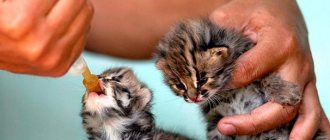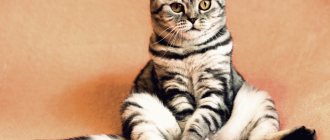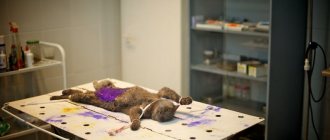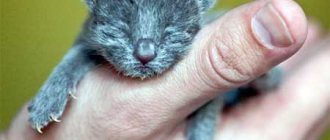In cases where small kittens, often newborns, are left without a mother, it is necessary to look for a replacement for natural feeding. The best option is for another animal to take care of the kittens, including feeding.
But if it is not possible to find a new mother for furry babies, then it is worth using special mixtures intended for kittens. The feeding process includes several main points. All of them are described in detail in this article.
Features of cat milk
Cat's milk contains certain vitamins, minerals, and specific antibodies that provide the baby's body with valuable nutrients and form its immune system. For this reason, in cases where a kitten requires artificial feeding, the optimal solution for caring owners is to purchase high-quality cat milk substitutes.
What are the properties of this product, and how to use it correctly? In order to correctly select a high-quality substitute, you need to have information about what is contained in natural cat milk, and how it fundamentally differs from the usual goat or cow milk.
First of all, it should be noted that cat colostrum is not fatty, since it consists of almost 70% water.
In terms of lactose and protein content, cat's milk is significantly superior not only to cow's milk, but even to female colostrum.
Feeding kittens
In order for babies to develop normally, they need a proper diet with the obligatory presence of vitamins. To create mixtures for kittens, you should get a small measuring cup. You also need to know how much weight of a particular component a teaspoon or tablespoon can hold. This knowledge will be useful when preparing mixtures.
All kitten formula recipes include dairy products. At best, food that replaces cat milk is purchased at pharmacies and pet stores. However, this option is not always suitable for everyone. Therefore, people use self-created mixtures to feed kittens.
To create a milk formula for a kitten, goat's milk with a fat content of up to 2.5% or cow's milk - 1.5% is often used. Once every 2 days, you can add the yolk of quail eggs and 2-3 drops of syrup consisting of 1 teaspoon of water and 1 teaspoon of sugar to the milk.
When the kittens open their eyes, they should be given any meat mixture intended for human children. At first, it replaces one milk feeding. A day later another one and so on.
The meat mixture (2.5 ml) should be diluted with one teaspoon of water, stirring until it becomes liquid sour cream. Kittens are fed through a syringe or pacifier. The solution is stored in the refrigerator for 24 hours.
What are substitutes and their composition
For artificial feeding of kittens, companies producing ready-made diets have released a special line of products called “cat milk replacers.” This product is most similar in composition to cat colostrum and includes the following elements:
- taurine (amino acid);
- complex of vitamin and mineral components;
- fatty acids (omega-3 and omega-6).
It is extremely important for owners to monitor the ratio and proportions of the ingredients contained in the substitute in this product. A deficiency of certain components, in particular omega fatty acids, can cause the development of serious pathologies in a kitten.
Substitutes are sold in dry, powder form, and are also available in liquid form. It is believed that the liquid product is more useful and is better absorbed. However, it should be remembered that its shelf life is much shorter than that of the substitute in dry form.
How does a cat's milk change over time?
Another interesting observation that scientists made is that the content of fat, protein, lactose and trace elements changes over the course of lactation.
Milk production can be divided into three periods: colostrum, transitional milk and mature milk. Colostrum is not exactly milk, and its composition is very different from mature milk. It is produced approximately in the first two days after the birth of kittens, there is little of it, and the nutrients in it are exactly in the amount that newborn kittens need.
More fat and protein
During the first week, colostrum is gradually replaced by mature milk, and the milk produced during this period is called transition milk. Interestingly, the fat and protein content increases over time, while the lactose level remains approximately the same.
This (of course, not only this!) cat's milk differs from women's milk and is more reminiscent of dog milk. In human milk, the concentration of protein and fat decreases over time, but in cats and dogs, on the contrary, it increases.
Scientists associate the increase in protein concentration with the predatory nature of cats. Even pets require particularly large amounts of protein throughout their lives (not just during lactation), since modern cats have not adapted to low-protein foods and still prefer the high-protein diet of their carnivorous ancestors.
As for fat content, kittens grow and require more and more energy, and fat is the most caloric of all nutritional substances.
In what cases is a substitute required?
Cat milk substitutes may be required if a nursing cat dies or the baby is weaned from the mother's breast. It is also impossible to do without this product if your cat has the following problems:
- mastitis;
- C-section;
- lack of colostrum or insufficient quantity.
Colostrum can be purchased on the market or in specialized factories, but this is quite difficult, expensive and not always available. In such situations, an excellent solution is a cat's milk substitute, which you can buy in specialized stores or prepare yourself at home.
Why is cat milk special?
At first glance, it may seem that cat milk is not significantly different from other types of milk. This is true: it has not only the same consistency and appearance, but also the same chemical composition. Only the ratio of the substances contained in it differs. In percentage terms they are distributed as follows :
- 70-75% – water;
- fat content is no more than 12%, which is noticeably lower (by about 6%) than in the milk of cows and goats;
- 3-5% falls on lactose;
- about 10% are proteins.
As you can see, cat milk is significantly different from regular milk. In addition, during the first feeding with mother's milk, special antibodies are transferred to the kittens, which protect the offspring from various viruses and form the babies' immunity. Therefore, it is impossible to fully replace mother’s milk for a kitten with natural analogues.
How to choose a cat milk replacer
There is a fairly wide selection of cat milk substitutes on the modern market. How not to make a mistake and purchase a truly high-quality product? Veterinary experts recommend giving preference to trusted manufacturers who have earned a good reputation and positive reviews. These include the following brands:
- Royal Canin.
- Nutri-Vet.
- Dolphos.
- Gimpet.
- Trixie.
The cost of the product should not be too low, although, of course, an inflated price is also not a guarantee of quality.
In addition, when choosing complementary foods, experts advise taking into account the following factors:
- Kitten breed. Kittens of different breeds have specific characteristics regarding the substances necessary for their full development, which must be supplied with food. You can get detailed advice from a veterinarian, breeder, or read all about your pet’s breed.
- The composition of the substitute, in addition to lactose, proteins and fats, must include a vitamin-mineral complex, amino acids, microelements and fatty acids.
- The fat content of the product must be at least 8.5%.
- Products containing starch and artificial substances are contraindicated, as this can cause the development of allergic reactions in the kitten or provoke disorders of the digestive system.
A high-quality cat's milk substitute must be homogeneous, have a pure and extremely natural composition.
Among the various cat milk substitutes presented on the modern market, veterinarians especially highlight brands such as Beafar, Royal Canin, Gimpet, noting that these products contain the optimal amount of proteins, lactose, omega acids, vitamins and minerals, essential amino acids proportions.
Rating of milk substitutes for kittens - composition, characteristics, price
- Gimpet fortified Cat-Milk with taurine;
- Royal Canin Babycat Milk;
- Nutri-Vet Kitten Milk;
- Kittenmilch CDVet.
Gimpet fortified Cat-Milk with taurine
Vitaminized dry formula from Germany is designed specifically for kittens without mother's milk, pregnant and lactating cats, weak and elderly animals.
The composition is as close as possible to the natural product. It has a balanced composition of proteins and fats: proteins – 35%, fats – 27%. The protein and fat components of the mixture are of animal origin, which fully satisfies the needs of the kitten’s growing body and protects its digestive tract. Taurine – maintains visual acuity and normalizes heart function. Natural arachidonic acid has been added for healthy skin and coat.
Main composition: milk and dairy products, fats and oils, plant components, minerals, milk sugar derivative. The mixture contains vitamins: A, D3, E, B1, B2, B6, K, B12, biotin, nicotinic acid, C, taurine, pantothenic acid, L-carnitine, folic acid. Mineral composition: calcium, copper, zinc, iron, iodine, selenium, manganese.
Recipe: 1 tablespoon of milk powder is mixed with 3 tablespoons of hot water and cooled to room temperature.
- Plus: full composition.
- Disadvantage: you need to additionally purchase a bottle and nipples for feeding.
Price: pack 200 gr. – 609 rub. More details about the product
Royal Canin Babycat Milk
Complete milk replacer for kittens from birth to 2 months from Royal Canin (France). Easily digestible by the kitten's stomach, the high-calorie food provides the growing body with the necessary nutrients and energy. Kittens fed on this food give a stable weight gain of up to 10 grams. in a day. Milk proteins, lactose and fructooligosaccharides provide digestive tract protection. Protein content – 33%, fat – 39%.
Main composition: milk proteins, animal fats, whey, coconut oil, soybean oil, fish oil, fructooligosaccharides, minerals, aromatic additives.
Vitamin and mineral composition: acids EPA and DHA, Omega-3, Omega-6, arachidonic acid, linoleic acid, calcium, sodium, phosphorus, potassium, manganese, zinc, iodine, selenium, copper, iron, A, E, C, D3, B1, B6, B2, B5, B12, biotin, choline, taurine. Dilute according to the instructions using a measuring spoon and the included bottle.
- Plus: the set includes a measuring spoon, a bottle and nipples with holes of different sizes.
- Cons: Contains fragrances.
Price: pack 300 gr. – 1110 rub. More details about the product
Nutri-Vet Kitten Milk
The dry fortified product from an American manufacturer is fully adapted to the needs of newborn kittens and pregnant cats. Can be used as a source of additional nutrition for lactating animals and elderly individuals. Milk is completely absorbed by the kitten’s body and contributes to its normal development. Protein content – 42%, fat – 25%.
Ingredients: vegetable oil, whey protein, skimmed milk powder, egg yolk, milk fat. Contains vitamin-mineral complex and biotin.
Recommendations for use: stir 1 part dry mixture in 2 parts warm water.
- Plus: the finished mixture can be stored in the refrigerator for up to 24 hours.
- Minus: sold only in online stores.
Price: pack 170 gr. – 863 rub. More details about the product
Kittenmilch CDVet
Milk replacer for kittens with colostrum is an absolutely natural product for feeding feline offspring. Can be used for milk deficiency in a nursing cat with large offspring.
Product composition: whole milk powder, colostrum, milk protein, sodium chloride, locust bean gum. Protein content – 29.42%, fat – 22.62%.
Recommendations for preparation: dilute 1 part of dry powder in 3 parts of hot water and cool to a temperature of 35-40°C.
- Plus: does not contain synthetic additives.
- Cons: high price.
Price: packaging 90 g. – 1145 rub., 750 gr. – 4419 rub. More details about the product
Making cat milk replacer at home
If desired, owners can prepare a cat's milk substitute themselves. This task requires time and certain skills, but the resulting product will be 100% natural, high quality and affordable, compared to store-bought counterparts. There are several most common, budget-friendly and easy-to-follow recipes:
- Recipe with cow's milk . To prepare the substitute, you will need about half a liter of high-quality, high-fat cow's milk. It is recommended to warm the milk a little, after which 4 tbsp should be added to it. sugar and egg yolk, mix thoroughly. To make the product more useful, you can add special vitamin complexes for kittens in the form of drops, which can be purchased at any veterinary pharmacy.
- Recipe with milk and glucose . This type of substitute is ideal for weak, premature and sick babies. To prepare this recipe you will need to combine glucose (20 ml), cow's milk (100 ml), vitamin supplements (0.3 ml). It is recommended to add an egg yolk and a tablespoon of sunflower oil to the finished product.
- Recipe with condensed milk . The basis of the substitute is high-quality milk (condensed) without sugar, which must be mixed with bone meal, maintaining a 1:1 ratio. This product is easily digestible and is suitable for feeding even newborn kittens.
- Recipe based on baby food. Often baby food is used to feed kittens. The “Malyutka” mixture has proven itself to be excellent and will need to be diluted with water according to the attached instructions.
Before choosing the best recipe, it is strongly recommended to consult with a veterinarian, who will help you choose the best option based on the breed, body weight and age of the kitten.
How to properly feed a kitten from birth to one month
It is important not only to choose the right formula for a newborn kitten, but also to prepare it correctly and give it to the baby. You will have to weigh the animal every day - stable weight gain confirms that the “child” is receiving the right amount of nutrients. On average, he should gain 10–15 grams per day.
General feeding rules
The main requirements when feeding a kitten are sterility of dishes and freshness of food. Bottles and nipples should be washed and boiled regularly. Strict requirements are placed on food temperature. A kitten can only digest liquids between 36 and 38°C. He will simply refuse to drink a cold mixture, and a hot one will cause him harm.
It is worth remembering that a newborn does not yet understand how to eat properly. In the first weeks you need to help him:
- Place the kitten on its tummy, raising its head slightly.
- Gently, without pressing, open your mouth with two fingers, carefully insert the pacifier at an angle of 45 degrees.
When feeding, you should hold the bottle at an angle of 45 degrees.
- To stimulate sucking, it is recommended to stroke the cat on the bridge of the nose, forehead or back. Do not put pressure on the throat and tummy.
It is forbidden to pour the mixture in a large stream - there is a risk that the kitten will choke.
Feeding equipment
You will need a miniature bottle and pacifier. They can be purchased at veterinary pharmacies. For example, for newborn kittens, the Hartz company produces a set - a container of optimal volume for a single meal (60 ml), a nipple 1 cm long and a tip diameter of 5 mm. This kit costs about 110 rubles.
You can buy a bottle and pacifier for feeding a kitten at a veterinary pharmacy.
You can skip the purchase of a veterinary kit and replace it with a regular glass eye dropper with a rubber tip or a syringe (without a needle). They are inexpensive (no more than 20 rubles), but since they are not designed for feeding kittens, they will be more difficult to use.
Video: how to feed a kitten from a bottle or syringe
How to dilute the mixture correctly
Preparation instructions are identical for all products:
- Using a measuring spoon (it is usually included in the finished mixture), select the required amount of powder (an indication of how much dry mixture to take will be on the packaging).
- Mix the dry mixture with preheated water in a ratio of 1:2.
- Shake the bottle for a minute until the mixture becomes homogeneous and without lumps.
- Check the temperature of the finished milk by pouring a drop on your wrist. At the desired temperature of the mixture, it will not cause practically any sensations in a person (which corresponds to the temperature of his body, which is also comfortable for a kitten).
After dilution, the mixture can be stored for no more than 1–2 hours. Refrigeration to be used the next day is prohibited.
Feeding frequency
The first days of a kitten’s life are the most important and difficult. They need food every 2 hours (including at night). On average, 7–9 feeding procedures are obtained. From the age of one week, kittens are fed as follows:
- The breaks between meals are increased to 3 hours, and at night it is allowed not to feed for 5 hours.
- From three weeks of age, the permissible feeding regimen is 5–6 times a day.
- At the age of 2–5 months, kittens are fed 4 times a day.
- From 5 to 8 months - 3 times a day.
- After 8 months - 1-2 times a day, as for adult cats.
How much food should be given, weight gain norms
The dosage of the finished mixture may vary slightly (depending on the composition of the product). On average, a single serving is calculated using the formula:
- for a kitten under 2 weeks old - 25–30 ml for every 120 grams of animal weight;
- 2-3 weeks - 45-50 ml for every 120 grams of animal weight;
- over 3 weeks - 75–60 ml for every 120 grams of animal weight.
The older the kitten, the less often it is fed, but the volume of milk per feeding increases
How long will it take for a kitten to eat on its own?
Starting from the fourth week, the kitten can be weaned off milk replacer. But they do it gradually. First, you should gradually feed your baby other foods, for example, soak pieces of dry food in the mixture until it turns into a paste.
Every day you should dilute the powder more until the baby begins to consume food and water that does not contain the mixture. Veterinarians recommend completely eliminating milk substitutes by about six weeks of age.
How to calculate dosage
When using cat milk substitutes, it is extremely important not only to choose a quality product, but also to correctly calculate the correct dosage. When determining the amount of complementary foods, it is necessary to take into account factors such as the age category and breed of the small pet.
An approximate dosage calculation is based on the baby’s age and is as follows:
| Kitten age | Required amount of mixture |
| 1-4 days | From 30 to 32 ml |
| 5 days – 2 weeks | From 37 to 39 ml |
| From 15 to 25 days | from 44 to 47 ml |
| 26-36 days | From 52 to 55 ml |
In this case, it is worth paying attention to the breed of the animal. Large kittens require a slightly larger amount of complementary feeding than pets of small breeds. However, these data are relative.
A caring owner should monitor the condition and behavior of the kitten very carefully in order to determine the optimal amount of milk replacer. For example, an underfed baby behaves anxiously and restlessly.
Overfeeding is no less dangerous for a kitten. Observing the kitten's stool will help determine the amount of food. So, with regular overeating, it becomes gray or green; slight overfeeding is manifested by yellowish feces.
Nutrition of newborn kittens without cat feeding
Depending on the characteristics of the cat’s body, feeding kittens lasts from 40 to 60 days.
At the beginning of life, the baby eats only mother's milk and feeding it does not present any problems. This period lasts several weeks. The first portions of a cat's milk are colostrum, which contains all the useful substances to protect the kitten from various, mainly infectious, diseases, that is, for antibacterial protection. With colostrum, a newborn kitten receives antibodies, and the largest amount is absorbed during the first 6 hours of life. Later, the mucous membrane of the stomach and intestines does not allow antibodies to enter the body. The mother cat's body begins to produce milk, rich in proteins, fats, vitamins and minerals. So, 1 liter of cat milk contains 70 g of protein.
During the first 8 days of life, the kitten's body weight doubles.
For comparison, a human child doubles its weight in 5-6 months, a foal in 60 days, and a calf in 47. The kitten suckles from its mother only 3 hours a day, and the rest of the time it grows. In order to determine whether a kitten is full or not, pay attention to its behavior: well-fed cubs sleep calmly or suckle the cat, while hungry ones squeak, crawl around their mother or suck the finger extended to them. In this case, you need to feed the kittens. Babies left without a mother will also need feeding.
To replace cat milk, you can use one of several recipes:
How to use it correctly
Milk substitutes should be given to newborn babies who do not yet know how to drink on their own using a bottle with a baby pacifier; in extreme cases, a disposable syringe without a needle will also be suitable for these purposes.
Before starting feeding, the mixture must be heated to a temperature of about 38–39°C.
It is recommended to store the prepared substitute in the refrigerator. The optimal storage period is no more than a day. To properly prepare cat milk replacer purchased in stores and veterinary pharmacies, you should pay special attention to the following recommendations from experts:
- The kitten's body is very susceptible to various types of pathogens. Therefore, it is important to use sterile containers for preparing complementary foods and feeding them. Before feeding, you should wash your hands thoroughly.
- It is recommended to avoid purchasing large packages of formula, although they may seem more economical. The fact is that during long-term storage, bacteria and microbes that are dangerous to the health of the baby can penetrate into the product.
- You should avoid feeding your animal from a spoon. Such experiments often end in the death of the kitten, because the baby can choke on the mixture. In addition, the food can enter the lungs and lead to the development of pneumonia.
- The dosage of food should be increased very carefully and gradually, taking into account the age norms of the kitten. In this case, you should carefully monitor the behavior, condition and stool of your pet to avoid overfeeding or malnutrition.
- The mixtures should be diluted exclusively with clean and warm boiled water in the ratio indicated on the package.
The mixture should be prepared according to the recommendations indicated on the packaging of the finished cat milk replacer of one or another brand.
Dishes for feeding kittens
You can feed kittens from bottles and syringes purchased at the pharmacy. Often, an ordinary disposable syringe without a needle is used for this purpose. The syringe must be replaced with a new one throughout the entire feeding period. Its lower end is sometimes rounded, treated with thin sandpaper or a file. Even in cases where the kitten initially does not immediately like this method of feeding, he will gradually get used to it and even begin to suck out the contents of the syringe.
A homemade device in the form of a bottle of used drops and a pipette is also suitable for feeding kittens. A bottle of eye drops, for example, chloramphenicol drops, is ideal. It resembles a baby bottle, and the top part is adapted for a nipple made from the rubber part of a pipette. Before use, all items are washed well and must be sterilized. Abandoned kittens have very weak immunity, so bottles and nipples must be sterilized and the syringe replaced with a new one.
When do kittens need artificial feeding?
The ideal situation is as follows: the cat cares for and feeds the kitten until it is approximately 8 weeks old. Only then can you separate the baby from his mother. But there are times when human intervention and help is required. Reasons why this may happen include:
- death of a cat;
- lack or deficiency of milk in her;
- mastitis and inflammation of the uterus in a cat;
- eclampsia in a cat, that is, calcium deficiency;
- psycho-emotional deviations of the animal.
Sometimes the mother feeds the kittens regularly, but the babies still need complementary foods. This situation may arise if the litter is very large. It happens that a weak kitten is born, which quickly gets tired when sucking - in this case, it also needs additional nutrition. How you manage to feed a kitten without a cat or simply intervene a little in the process will determine its future health.
Calculation of daily portions
In the natural environment, a cat does not control the amount of milk her kittens eat. But since the task is to feed a kitten without a cat, certain standards must be observed. The baby quickly gains weight, but his stomach volume is very small, so feeding should be dosed. The daily intake of the mixture depends on the age of the baby. Below is the amount calculated per 100 g of animal body weight:
- from birth to day 5 – 30 ml;
- from 6 to 14 days – 38 ml;
- from 15 to 24 days – 45 ml;
- from the 25th day and over the next month - 55 ml.
These are recommended figures and may vary slightly for each breed. The daily volume must be divided by the number of feedings. The most preferable option, as for humans, is in small portions, but more often.
How to feed a small kitten: features and rules
There are certain rules and nuances of feeding a kitten. This applies to both the feeding regimen and procedures after it.
What things will you need?
To feed a kitten, you will have to purchase some items. A bottle with a special nipple will be more convenient for you and better for the animal: such a thing is sold in a veterinary pharmacy. It has an anatomically correct shape and resembles a cat's nipples.
You can feed newborn kittens without a cat either with a pipette or with a syringe without a needle. But this option is undesirable, since during feeding, air may enter the esophagus or milk may enter the respiratory tract, causing the animal to choke or regurgitate. It is very important to wash and sterilize items after each feeding.
Stages of the procedure
When everything you need has been collected and sterilized, dilute the mixture according to the instructions and heat it. It is not recommended to do this in the microwave - the mixture may warm up unevenly - it is better to heat it in a water bath.
Check your pet's body temperature. If the paws are cold, the kitten is cold, which means the food will be digested much worse. The baby must be kept warm at all times. To do this, place a heating pad wrapped in a towel or a bottle of hot water in his box or house.
When you are sure that the kitten is warm, you can proceed directly to the feeding process. To do this, lay a towel on your knees, carefully lay the kitten on its stomach and lift its head a little - this is the position in which kittens feed from their mother. For the very first time, you should moisten the nipple's spout with milk so that the baby smells the food and begins to eat.
How to determine if a kitten is full
Both conditions are extremely undesirable and even dangerous for a baby: underfeeding and overfeeding. If he doesn't get enough food, he doesn't gain weight well and appears lethargic. Overeating is indicated by loose stools in yellow, green and gray shades. You can visually determine whether the kitten is full in the following way: extend your finger to it. If the animal begins to suck, then it is not full.
The baby’s behavior is also an indicator. If the kitten is full, he simply turns away and falls asleep, sometimes milk bubbles come out of his mouth, if not, he squeaks, crawls and looks for a pacifier.
What to do after feeding
During the process, try your best to ensure that the animals are calmed by your voice. Talk to them and be sure to pet them, and after feeding, wipe off any remaining food from their faces.
At the end of feeding, lightly press the kitten's back against your stomach and gently stroke its tummy. With these actions you stimulate belching and start the process of digesting food.
To prevent kittens from suffering from constipation, it is necessary to massage their anus. This is done with cotton pads or ear swabs, which are dipped in Vaseline.
Artificial stimulation of peristalsis does not always help, and babies experience stool retention. In this case, you need to give an enema, but it is better to do this under the supervision of a veterinarian - leave the procedure to him for the first time, later you will learn how to give enemas to kittens yourself.
Difficulties and errors
The main and most serious mistake is a frivolous attitude towards what and in what quantities you feed the kitten. This can lead to serious problems with his health.
Pay attention to the position in which the baby eats. If you place it on its back, the mixture may enter the lungs while eating, and this often leads to death. It happens that milk comes out of the nose and the stomach swells greatly - this means that the baby has swallowed a lot of air and is trying to burp. During feeding, be sure to ensure the correct position.
If it is still acceptable to feed a kitten with a syringe at the initial stage, then experts do not recommend doing it from a spoon - such actions can lead to the fact that the sucking reflex disappears, and the baby will not be able to eat normally in the future.











